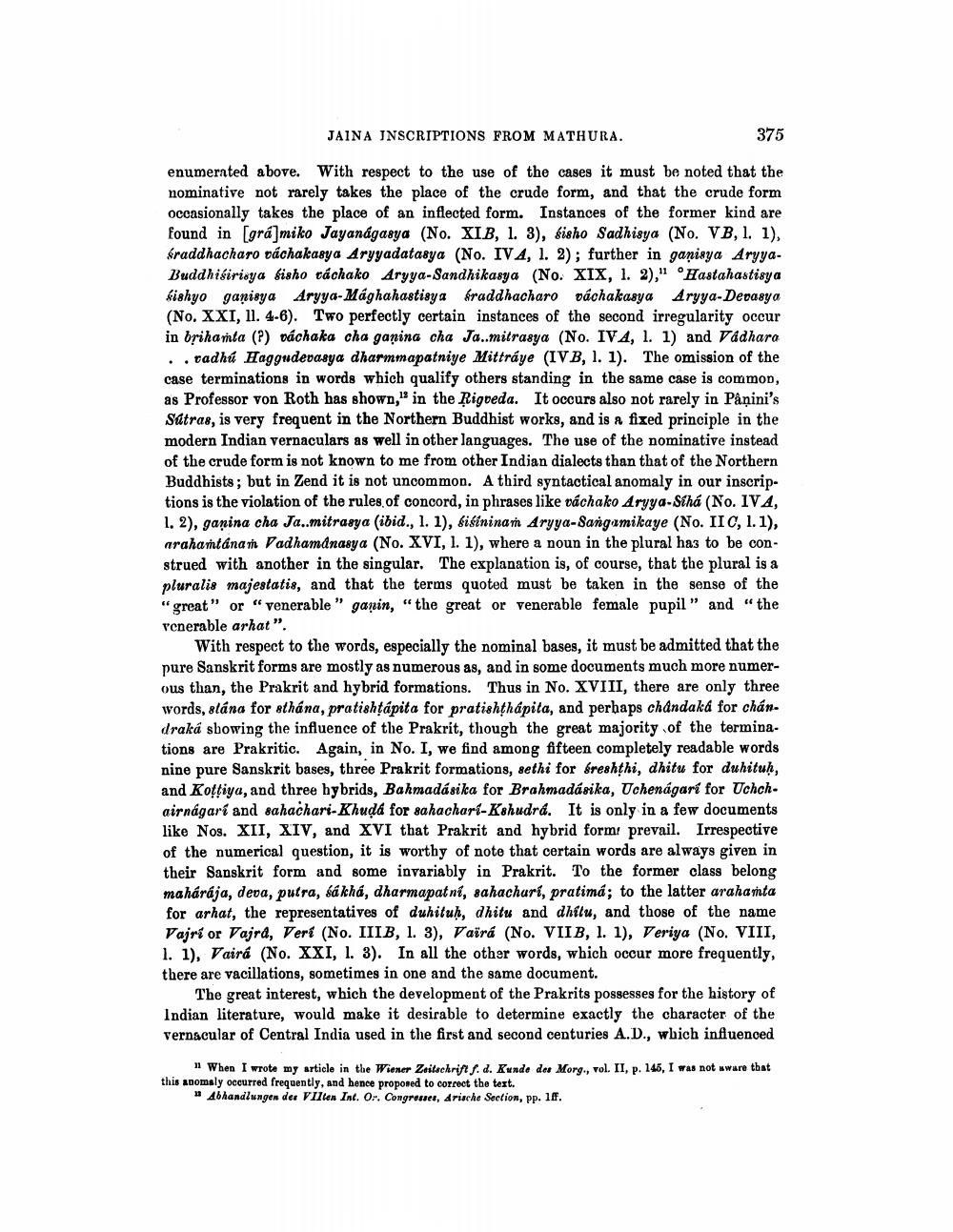________________
JAINA JNSCRIPTIONS FROM MATHURA.
375
enumerated above. With respect to the use of the cases it must be noted that the nominative not rarely takes the place of the crude form, and that the crude form occasionally takes the place of an inflected form. Instances of the former kind are found in [grá]miko Jayanagasya (No. XIB, 1. 3), bisho Sadhisya (No. VB, 1. 1), Graddhacharo váchakasya Aryyadatasya (No. IVA, I. 2); further in ganiaya AryyaBuddhisirisya bisho táchako Aryya-Sandhikasya (No. XIX, l. 2)," Hastahastisya kishyo ganisya Aryya-Mághahastisya Sraddhacharo váchakasya Aryya-Devasya (No. XXI, 11. 4-6). Two perfectly certain instances of the second irregularity occur in brihanta (?) váchaka cha ganina cha Ja..mitrasya (No. IVA, 1. 1) and Tadhara .. tadhú Haggudevasya dharmmapatniye Mittraye (IVB, 1. 1). The omission of the case terminations in words which qualify others standing in the same case is common, as Professor von Roth has shown in the Rigveda. It occurs also not rarely in Påņini's Sátras, is very frequent in the Northern Buddhist works, and is a fixed principle in the modern Indian vernaculars as well in other languages. The use of the nominative instead of the crude form is not known to me from other Indian dialects than that of the Northern Buddhists; but in Zend it is not uncommon. A third syntactical anomaly in our inscriptions is the violation of the rules of concord, in phrases like váchako Aryya-Siha (No. IVA, 1.2), ganina cha Ja..mitrasya (ibid., 1. 1), bisininan Aryya-Sangamikaye (No. IIC, 1.1), arahantánam Vadhamanasya (No. XVI, 1. 1), where a noun in the plural has to be construed with another in the singular. The explanation is, of course, that the plural is a pluralis majestatis, and that the terms quoted must be taken in the sense of the "great" or " venerable" ganin, “the great or venerable female pupil” and “the venerable arhat".
With respect to the words, especially the nominal bases, it must be admitted that the pure Sanskrit forms are mostly as numerous as, and in some documents much more numerous than, the Prakrit and hybrid formations. Thus in No. XVIII, there are only three words, slána for sthána, pratishțápita for pratishthápita, and perhaps chandaka for chán. draká showing the influence of the Prakrit, though the great majority of the terminations are Prakritic. Again, in No. I, we find among fifteen completely readable words nine pure Sanskrit bases, three Prakrit formations, sethi for Sreshthi, dhitu for duhituh, and Kottiya, and three hybrids, Bahmadásika for Brahmadásika, Uchenagari for Uchchgirnagari and sahachari-Khuda for sahachari-Kshudra. It is only in a few documents like Nos. XII, XIV, and XVI that Prakrit and hybrid form prevail. Irrespective of the numerical question, it is worthy of note that certain words are always given in their Sanskrit form and some invariably in Prakrit. To the former class belong mahárája, deva, putra, sá khá, dharmapatni, sahachari, pratima; to the latter arahamta for arhat, the representatives of duhituh, dhitu and dhitu, and those of the name Vajri or Vajra, Veri (No. IIIB, 1. 3), Vairá (No. VIIB, 1. 1), Veriya (No. VIII, 1. 1), Vaira (No. XXI, 1. 3). In all the other words, which occur more frequently, there are vacillations, sometimes in one and the same document.
The great interest, which the development of the Prakrits possesses for the history of Indian literature, would make it desirable to determine exactly the character of the vernacular of Central India used in the first and second centuries A.D., which influenced
When I wrote my article in the Wiener Zeitschrift f. d. Kunde der Morg., vol. II, p. 145, I was not aware that this anomaly occurred frequently, and hence proponed to correct the text.
Abhandlungen der Vilten Int. Or. Congresses, drische Section, pp. 1ff.




